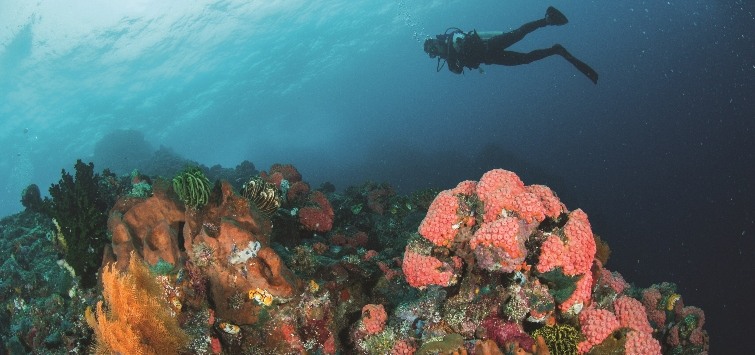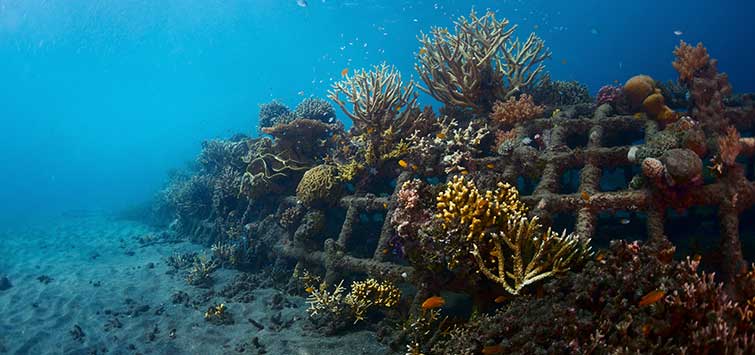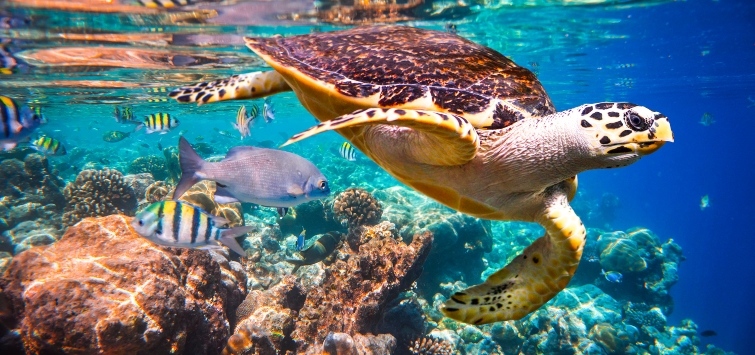Ambon Fish: The Hidden Biodiversity of a Spice Island
Located in the heart of the Coral Triangle, the waters of Maluku are estimated to harbor around 1,500 species of fish, which places Ambon near the top of any list in terms of the diversity of its aquatic life.
Until very few years ago, only a very limited number of scuba divers and explorers operating from big live-on-board boats were able to explore Ambon fish, and in general, the Banda Sea. Today, a few diving centers serve the island, thanks to better travel connections and improved infrastructures, with direct flights from Jakarta, the capital city of Indonesia.
A New Discovery

The new frogfish’s biology and life history are not very well known yet, even if some anecdotal data—collected mostly by diving guides in the area—are suggesting that it is likely to be a fish living at medium depths of about 330 feet (100 meters), coming to shallower waters for the reproductive season and to lay (or carry) its eggs. The high frequency of sightings of female individuals carrying eggs could indicate that psychedelic frogfishes come to shallow waters for spawning purposes, but nothing else is known about their larval dispersal, home range, or even life length. Ambon’s waters are full of mysteries.
Normally, animals with very noticeable colors want to be seen, as they are normally toxic or pretending to be poisonous (like nudibranchs, for example). It would be interesting to understand why the psychedelic frogfish has evolved this flashy coloration, as like the other members of the Antennariidae family, it is an ambush predator that relies on camouflage to stage its sneak attacks. (When I saw a photo of it for the first time, it reminded me of a colonial ascidian, but it could be only by chance that they look alike.)
Scorpionfish: Masters of Camouflage
Unfortunately, during my visit in Ambon, I was not lucky enough to have a psychedelic frogfish turn up in front of my camera. But even without psychedelic fishes, Ambon Bay hosts an incredible number of benthic fish that use their amazing mimicry abilities to hide and hunt their prey. The dark sand, low water clarity, and abundance of small corals create the perfect habitat for ambush predators like frogfishes and Rhinopias scorpionfishes. Patience is their main virtue, waiting close to the objects they resemble (sponges, weeds, corals) until a prey animal makes a mistake.Even if they sometimes go unnoticed by divers (mimicry definitely works!), scorpionfishes are a magnificent showcase of adaptation to a specific environment. A typical example of beautiful ugliness is the Ambon scorpionfish (Pteroidichthys amboinensis), which lives primarily in algae or soft-bottom habitats and can be easily overlooked because of its superb camouflage.
There are six different Rhinopias species in the world, and two of them (R. eschmeyeri and R. frondosa) are commonly found in Ambon Bay. R. eschmeyeri (also called the paddle-flap scorpionfish) is generally easy to recognize, as its body is normally lacking appendages. R. frondosa, or the weedy scorpionfish, comes in two different forms, one with many “weedy” appendices and another one very similar to the paddle flap but with without notches in the dorsal fin.
Rhinopias have been for years a Holy Grail for many underwater photographers, who today can fly to Ambon with a reasonably good probability of spotting at least a few. My first Rhinopias was indeed photographed in Ambon, after years of unsuccessful hunting in Sulawesi, Bali, and even the Philippines.
Many different frogfish species live in sheltered bays around Ambon. Their body is often covered with spots, filaments (typical of Antennarius striatus, the striped/hairy frogfish), false ocelli (as on A. pictus, the painted frogfish), irregular areas, and sponge-like structures, and the color of the body can change to adapt to their surroundings.
A change in color can take a few days, and during this process, these Ambon fish can be any color between the starting color and the new one. For example, changing from white to dark red, the fish can be yellow, orange, or brown. Juvenile frogfishes often look like toxic nudibranchs or flatworms because of a defensive camouflage mechanism called “Batesian mimicry.” Even juvenile flatfishes, like soles, use this trick. Some little flatfishes even move like flatworms, and it is very difficult to tell if they are actually juvenile fishes. (The trick is to find the little eye, which is absent in flatworms.) They are not toxic, but most predators won’t take the risk and would opt for something less dangerous.
Little Mimics
As in many other remote areas of Indonesia, any microhabitat can be the place where you find a fish species unknown to science. This happened just a couple of years ago when a group of divers noticed a small, white or pale-pink goby hiding inside a white lace coral (which in reality is not a coral but a bryozoan). After sending the photographs to international fish experts, the fish was deemed undescribed and named Sueviota bryozophila, or bryozoan goby. Apparently, only 5 percent of bryozoan colonies host one or more gobies, so the fish is not easy to find, and it remained unnoticed until very recently.Bottom-dwelling fishes do not have exclusive rights on mimicry skills either. Ghost pipefishes, as their name implies, are masters in this art, and the shallow waters of Ambon Bay are particularly attractive for these fish. After a pretty long larval stage, juvenile ghost pipefish settle in shallow reefs where they can change color depending on the surroundings. Some of them like to live in proximity of crinoids (or feather stars), especially the harlequin ghost pipefish (Solenostomus paradoxus), which can easily blend into the natural background, thanks to its patchwork body coloration and typical swimming position, with the mouth facing downward and oscillating with the waves.
Cardinalfish
Sheltered inside crevices and coral branches, the mainly nocturnal cardinalfish of the family Apogonidae have a place to thrive in Ambon. During the day, they normally remain in proximity of the shelter of coral and rock crevices, where they find refuge if disturbed by a predator (or a noisy, bubble-making underwater photographer with big strobes). Many species are solitary or live in small groups, while others form large aggregations in little caves or below coral bommies.I have counted more than seven different species of cardinalfishes in Ambon, most of them living inside sheltered bays with some showing one of the most famous characteristics of this family: paternal mouthbrooding, in which the father fish holds the pair’s fertilized eggs for several days before releasing the larvae into the oceanic currents. The father doesn’t eat anything during the eggs’ incubation, so he is even more shy and lazy than normal during this period; he cannot afford to stray and risk unnecessarily expending the energy it takes to escape from predators. The popular Banggai cardinalfish (which is not present in Ambon for now, but as it was already introduced in North Sulawesi and North Bali, it may arrive in Ambon someday) has further increased this protection, with the father keeping the juveniles in his mouth over a longer duration.
Boxfish and Puffers

Interesting Inverts
Marine invertebrate life is similarly amazing. Given the low visibility in the region—with copious sediment suspended in the water, especially inside Ambon Bay—photosynthetic (or hermatypic) corals are not extremely abundant, even if there are some colonies struggling to capture the heavily dimmed solar light. But nudibranchs and several species of cephalopods—some of them occupying cans, bottles, and other objects of human origin—are very common even in shallow waters, and local dive guides are amazing at finding even the smallest of these unusual creatures.Pretty common is the encounter with the flamboyant cuttlefish (Metasepia pfefferi), which gets its name from the animal’s unique ability to display bright, flame-like colors if disturbed. As its flesh contains acids that make it unsuitable for human consumption, this cephalopod is spared from commercial fishing, so it is common all around Indonesia, especially on dark, sandy bottoms. The eggs are completely transparent, and the juvenile cuttlefish immediately after hatching are miniature carbon copies of the adults.
A Hidden Hotspot of Biodiversity
Outside the bay, very colorful fringing reefs populate the coasts of big and small islands, and there are chances to encounter big predators like tunas and sharks patrolling the reef hunting for food.The Spice Islands remain a hidden gem, but they are beginning to open up their underwater wonders to the world. If you want to experience the thrill of exploration in a hotspot of hidden biodiversity, book a flight to Ambon, and when you arrive, just put your head underwater. You will not be disappointed!
See the full article on TFH Digital
https://www.tfhdigital.com/tfh/sep_oct_2018/MobilePagedReplica.action?pm=2&folio=60#pg63




